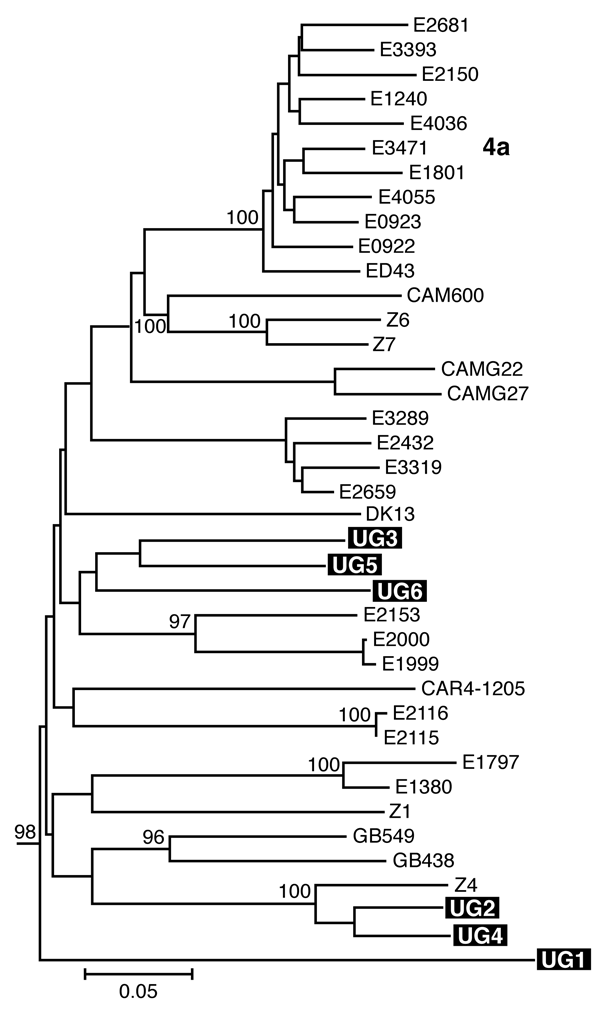Volume 12, Number 9—September 2006
Dispatch
Hepatitis C Virus Genotype 4 in Ugandan Children and Their Mothers
Figure 2

Figure 2. Estimated phylogenies of hepatitis C virus genotype 4; Core/E1 phylogenetic analysis based on 340 bp spanning the junction between the Core and E1 regions. Ugandan sequences determined in this study are highlighted in black. Numerical values (presented when >60%) represent the statistical support for the tree topology as determined by 1,000 bootstrap replicates. Reference sequences for genotypes 1–3, 5, and 6 (7) were included in both analyses and retained as the outgroup. Accession numbers are provided in the text.
References
- Madhava V, Burgess C, Drucker E. Epidemiology of chronic hepatitis C virus infection in sub-Saharan Africa. Lancet Infect Dis. 2002;2:293–302. DOIGoogle Scholar
- Callahan JD, Constantine NT, Kataaha P, Zhang X, Hyams KC, Bansal J. Second generation hepatitis C virus assays: performance when testing African sera. J Med Virol. 1993;41:35–8. DOIGoogle Scholar
- Tess BH, Levin A, Brubaker G, Shao J, Drummond JE, Alter HJ, Seroprevalence of HCV in the general population of northeast Tanzania. Am J Trop Med Hyg. 2000;62:138–41.
- Jackson JB, Guay L, Goldfarb J, Olness K, Ndugwa C, Mmiro F, Hepatitis C virus antibody in HIV-1 infected Ugandan mothers. Lancet. 1991;337:551. DOIGoogle Scholar
- Mbulaiteye SM, Biggar RJ, Bakaki PM, Pfeiffer R, Whitby D, Ower AM, Human herpesvirus 8 infection and transfusion history in children with sickle cell disease in Uganda. J Natl Cancer Inst. 2003;95:1330–5. DOIGoogle Scholar
- Enomoto N, Takada A, Nakao T, Date T. There are two major types of hepatitis C virus in Japan. Biochem Biophys Res Commun. 1990;170:1021–5. DOIGoogle Scholar
- Ray SC, Arthur RR, Carella A, Bukh J, Thomas DL. Genetic epidemiology of hepatitis C virus throughout Egypt. J Infect Dis. 2000;182:698–707. DOIGoogle Scholar
- Oni AO, Harrison TJ. Genotypes of hepatitis C virus in Nigeria. J Med Virol. 1996;49:178–86. DOIGoogle Scholar
- Simonsen L, Kane A, Lloyd J, Zaffran M, Kane M. Unsafe injections in the developing world and transmission of bloodborne pathogens: a review. Bull World Health Organ. 1999;77:789–800.
- Rall CJN, Dienstage JL. Epidemiology of hepatitis C virus infection. Semin Gastrointest Dis. 1995;6:3–12.
- Menendez C, Sanchez-Tapias JM, Kahigwa E, Mshinda H, Costa J, Vidal J, Prevalence and mother-to-infant transmission of hepatitis viruses B, C, and E in southern Tanzania. J Med Virol. 1999;58:215–20. DOIGoogle Scholar
- Salemi M, Vandamme AM. Hepatitis C virus evolutionary patterns studied through analysis of full-genome sequences. J Mol Evol. 2002;54:62–70. DOIGoogle Scholar
- Ndjomou J, Pybus OG, Matz B. Phylogenetic analysis of hepatitis C virus isolates indicates a unique pattern of endemic infection in Cameroon. J Gen Virol. 2003;84:2333–41. DOIGoogle Scholar
- Medhat A, Shehata M, Magder LS, Mikhail NN, Abdel-Baki L, Nefah M, Hepatitis C in a community in Upper Egypt: risk factors for infection. Am J Trop Med Hyg. 2002;66:633–8.
- Al-Knawy B, Okamoto H, Ahmed El-Mekki A, Elbagir Khalafalla M, Al Wabel A, Qazi F, Distribution of hepatitis C genotype and co-infection rate with hepatitis G in Saudi Arabia. Hepatol Res. 2002;24:95. DOIGoogle Scholar
Page created: November 17, 2011
Page updated: November 17, 2011
Page reviewed: November 17, 2011
The conclusions, findings, and opinions expressed by authors contributing to this journal do not necessarily reflect the official position of the U.S. Department of Health and Human Services, the Public Health Service, the Centers for Disease Control and Prevention, or the authors' affiliated institutions. Use of trade names is for identification only and does not imply endorsement by any of the groups named above.